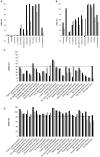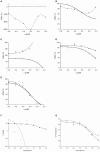Tuning a 96-well microtiter plate fluorescence-based assay to identify AGE inhibitors in crude plant extracts
- PMID: 24256925
- PMCID: PMC6270619
- DOI: 10.3390/molecules181114320
Tuning a 96-well microtiter plate fluorescence-based assay to identify AGE inhibitors in crude plant extracts
Abstract
Advanced glycation end-products (AGEs) are involved in the pathogenesis of numerous diseases. Among them, cellular accumulation of AGEs contributes to vascular complications in diabetes. Besides using drugs to lower blood sugar, a balanced diet and the intake of herbal products potentially limiting AGE formation could be considered beneficial for patients' health. The current paper presents a simple and cheap high-throughput screening (HTS) assay based on AGE fluorescence and suitable for plant extract screening. We have already implemented an HTS assay based on vesperlysines-like fluorescing AGEs quickly (24 h) formed from BSA and ribose under physiological conditions. However, interference was noted when fluorescent compounds and/or complex mixtures were tested. To overcome these problems and apply this HTS assay to plant extracts, we developed a technique for systematic quantification of both vesperlysines (λ(exc) 370 nm; λ(em) 440 nm) and pentosidine-like (λ(exc) 335 nm; λ(em) 385 nm) AGEs. In a batch of medicinal and food plant extracts, hits were selected as soon as fluorescence decreased under a fixed threshold for at least one wavelength. Hits revealed during this study appeared to contain well-known and powerful anti-AGE substances, thus demonstrating the suitability of this assay for screening crude extracts (0.1 mg/mL). Finally, quercetin was found to be a more powerful reference compound than aminoguanidine in such assay.
Figures







References
-
- Maillard L.C. Action des acides aminés sur les sucres; formation des mélanoïdes par voie méthodique. C. R. Acad. Sci. 1912;154:66–67.
-
- WHO Diabetes. [(accessed 20 June 2012)]. Available online: http://www.who.int/topics/diabetes_mellitus/en/
Publication types
MeSH terms
Substances
LinkOut - more resources
Full Text Sources
Other Literature Sources

